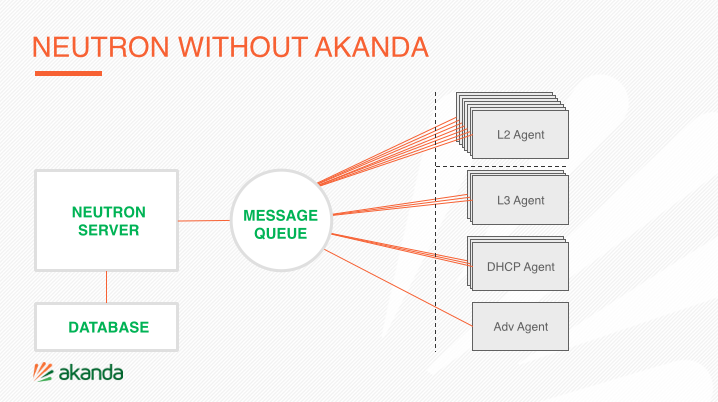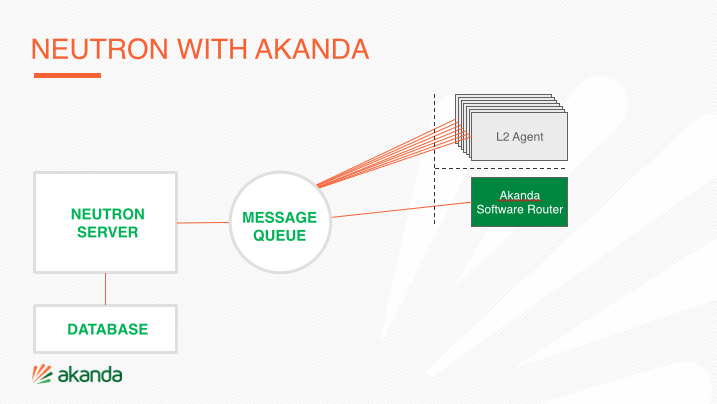3.8 KiB
High-Level Architecture
Akanda is a network orchestration platform that delivers network services (L3-L7) via VMs that provide routing, load balancing, firewall and more. Akanda also interacts with any L2 overlay - including open source solutions based on OVS and Linux bridge (VLAN, VXLAN, GRE) and most proprietary solutions - to deliver a centralized management layer for all OpenStack networking decisions.
In a canonical OpenStack deployment, Neutron server emits L3 and DHCP messages which are handled by a variety of Neutron agents (the L3 agent, DHCP agent, agents for advanced services such as load balancing, firewall, and VPN as a service):
When we add Akanda into the mix, we're able to replace these agents with a virtualized Service VM that manages layer 3 routing and other advanced networking services, significantly lowering the barrier of entry for operators (in terms of deployment, monitoring and management):
Akanda takes the place of many of the agents that OpenStack Neutron communicates with (L3, DHCP, LBaaS, FWaaS) and acts as a single control point for all networking services. By removing the complexity of extra agents, Akanda can centrally manage DHCP and L3, orchestrate load balancing and VPN Services, and overall reduce the number of components required to build, manage and monitor complete virtual networks within your cloud.
Akanda Building Blocks
From an architectural perspective, Akanda is composed of a few subprojects:
akanda-rug <rug>A service for managing the creation, configuration, and health of Akanda Serivce VMs in an OpenStack cloud. The :py
akanda-rugacts in part as a replacement for Neutron's various L3-L7 agents by listening for Neutron AMQP events and coalescing them into software router API calls (which configure and manage embedded services on the Service VM). Additionally, :pyakanda-rugcontains a health monitoring component which monitors health and guarantees uptime for existing Service VMs.akanda-appliance <appliance>The software and services (including tools for building custom router images themselves) that run on the virtualized Linux router. Includes drivers for L3-L7 services and a RESTful API that :py
akanda-ruguses to orchestrate changes to router configuration.Addon API extensions and plugins for OpenStack Neutron which enable functionality and integration with the Akanda project, notably Akanda router appliance interaction.
Software VM Lifecycle
As Neutron emits events in reaction to network operations (e.g., a
user creates a new network/subnet, a user attaches a virtual machine to
a network, a floating IP address is associated, etc...), :pyakanda-rug receives these
events, parses, and dispatches them to a pool of workers which manage
the lifecycle of every virtualized router.
This management of individual routers is handled via a state machine per router; as events come in, the state machine for the appropriate router transitions, modifying its virtualized router in a variety of ways, such as:
- Booting a virtual machine for the router via the Nova API (if one doesn't exist).
- Checking for aliveness of the router via the
REST API <appliance_rest>on the Service VM.- Pushing configuration updates via the
REST API <appliance_rest>to configure routing and manage services (such asiptables,dnsmasq,bird6, etc...).- Deleting virtual machines via the Nova API (e.g., when a router is deleted from Neutron).

